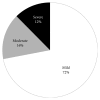Severity, Treatment, and Outcome of Acute Pancreatitis in Thailand: The First Comprehensive Review Using Revised Atlanta Classification
- PMID: 28487729
- PMCID: PMC5406724
- DOI: 10.1155/2017/3525349
Severity, Treatment, and Outcome of Acute Pancreatitis in Thailand: The First Comprehensive Review Using Revised Atlanta Classification
Abstract
Background. Severity and outcome of acute pancreatitis (AP) in Thailand are unknown. Methods. A retrospective study of 250 patients with AP during 2011-2014 was performed. Severity, treatment, and outcome were evaluated. Severity was classified by revised Atlanta classification. Results. The mean age was 58 years and 56% were men. Etiologies were gallstones (45%), alcohol (16%), postendoscopic retrograde cholangiopancreatography (14%), and idiopathic (15%). Overall, 72%, 16%, and 12% of patients had mild, moderately severe, and severe AP, respectively. Two major types of initial intravenous fluid were normal saline (64%) and Ringer's lactate solution (RLS, 28%). Enteral nutrition was given in 77% of patients with severe AP, median duration 48 hours, and via a nasogastric tube in 67% of patients. Necrotizing pancreatitis (NP) developed in 7% of patients, and 29% of them developed infection (median 17 days). The median length of stay was 6, 9, and 13 days, and the mortality rate was 1%, 3%, and 42% in mild, moderately severe, and severe AP, respectively. The overall mortality rate was 6%. Conclusion. The severity of AP in Thailand was mild, moderately severe, and severe in 72%, 16%, and 12% of patients, respectively. NP was not prevalent. Mortality was high in severe AP. Most treatments complied with standard guidelines except the underuse of RLS.
Figures
Similar articles
-
Fluid resuscitation in acute pancreatitis: Normal saline or lactated Ringer's solution?World J Gastroenterol. 2015 Aug 21;21(31):9367-72. doi: 10.3748/wjg.v21.i31.9367. World J Gastroenterol. 2015. PMID: 26309362 Free PMC article.
-
How severe is moderately severe acute pancreatitis? Clinical validation of revised 2012 Atlanta Classification.World J Gastroenterol. 2017 Nov 21;23(43):7785-7790. doi: 10.3748/wjg.v23.i43.7785. World J Gastroenterol. 2017. PMID: 29209119 Free PMC article.
-
Severity assessment of acute pancreatitis using CT severity index and modified CT severity index: Correlation with clinical outcomes and severity grading as per the Revised Atlanta Classification.Indian J Radiol Imaging. 2017 Apr-Jun;27(2):152-160. doi: 10.4103/ijri.IJRI_300_16. Indian J Radiol Imaging. 2017. PMID: 28744075 Free PMC article.
-
Recent Treatment Strategies for Acute Pancreatitis.J Clin Med. 2024 Feb 8;13(4):978. doi: 10.3390/jcm13040978. J Clin Med. 2024. PMID: 38398290 Free PMC article. Review.
-
Viral-Attributed Acute Pancreatitis: A Systematic Review.Dig Dis Sci. 2021 Jul;66(7):2162-2172. doi: 10.1007/s10620-020-06531-9. Epub 2020 Aug 12. Dig Dis Sci. 2021. PMID: 32789532
Cited by
-
Clinical, Biochemical, and Radiological Correlation in the Severity of Acute Pancreatitis: A Retrospective Study.Cureus. 2023 Feb 14;15(2):e34996. doi: 10.7759/cureus.34996. eCollection 2023 Feb. Cureus. 2023. PMID: 36938172 Free PMC article.
-
Clinical Prediction Score for Early Diagnosis of Acute Pancreatitis in Emergency Departments.Open Access Emerg Med. 2022 Jul 26;14:355-366. doi: 10.2147/OAEM.S371237. eCollection 2022. Open Access Emerg Med. 2022. PMID: 35924030 Free PMC article.
-
Novel anthropometric indicators of visceral obesity predict the severity of hyperlipidemic acute pancreatitis.Lipids Health Dis. 2024 Apr 23;23(1):120. doi: 10.1186/s12944-024-02112-1. Lipids Health Dis. 2024. PMID: 38654370 Free PMC article.
-
B Cells and Double-Negative B Cells (CD27-IgD-) Are Related to Acute Pancreatitis Severity.Diseases. 2024 Jan 5;12(1):18. doi: 10.3390/diseases12010018. Diseases. 2024. PMID: 38248369 Free PMC article.
-
Sequential organ failure assessment score is superior to other prognostic indices in acute pancreatitis.World J Crit Care Med. 2021 Nov 9;10(6):355-368. doi: 10.5492/wjccm.v10.i6.355. eCollection 2021 Nov 9. World J Crit Care Med. 2021. PMID: 34888161 Free PMC article.
References
-
- Pongprasobchai S. Acute pancreatitis: evidence-based management. Thai Journal of Gastroenterology. 2004;5(2):111–122.
-
- Banks P. A., Bollen T. L., Dervenis C., et al. Classification of acute pancreatitis-2012: revision of the Atlanta classification and definitions by international consensus. Gut. 2013;62(1):102–111. - PubMed
-
- Pramoolsinsap C., Kurathong S. Pancreatitis: an analysis of 106 patients admitted to Ramathibodi Hospital during 1969-1984. Journal of the Medical Association of Thailand. 1989;72(2):74–81. - PubMed
LinkOut - more resources
Full Text Sources
Other Literature Sources
Miscellaneous




